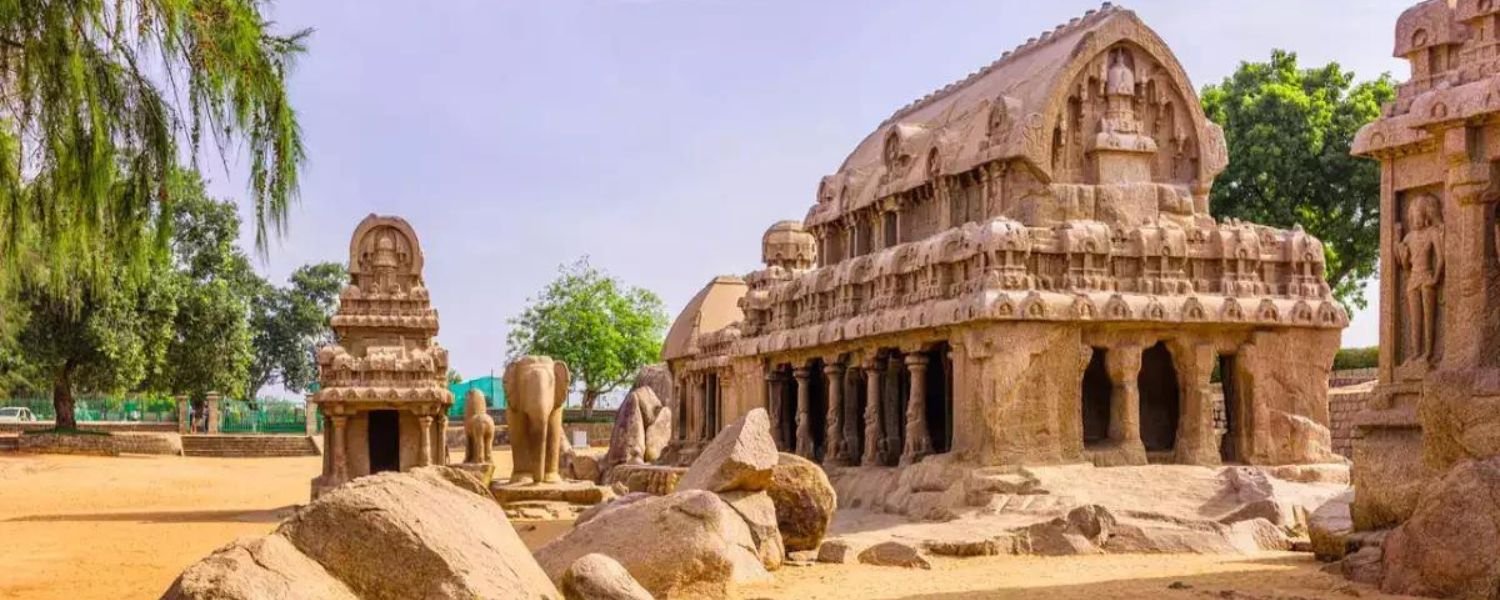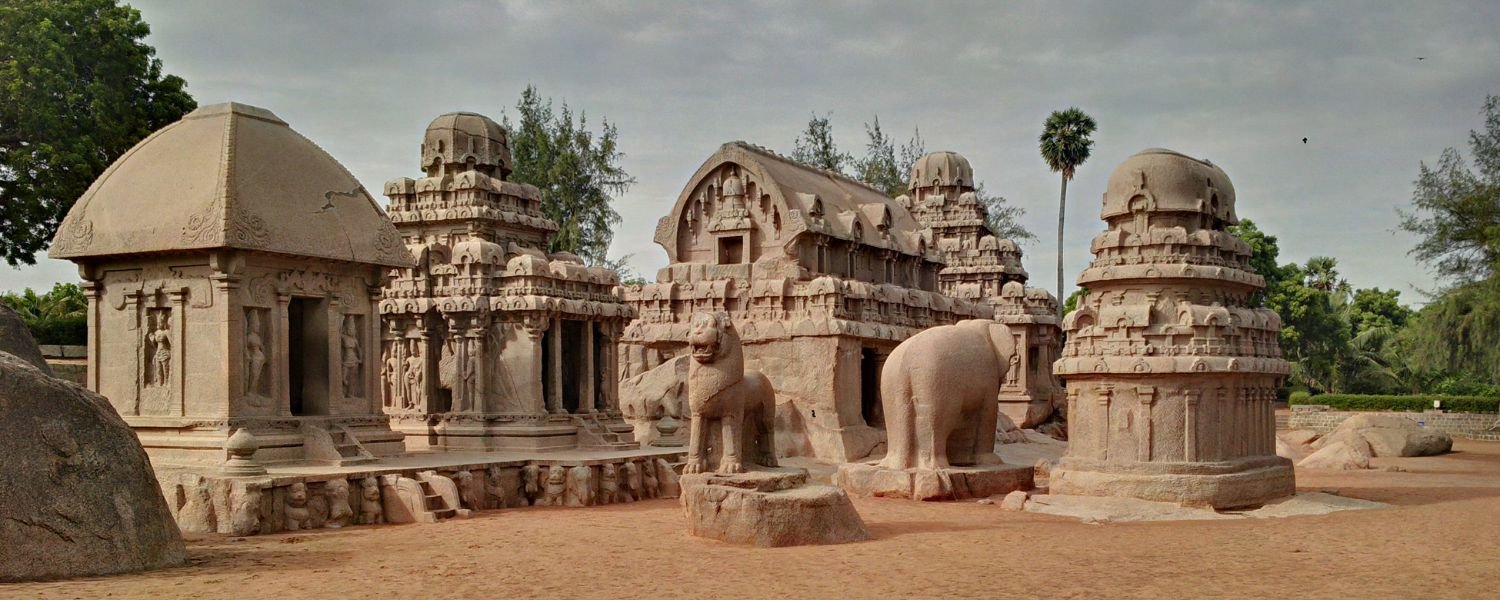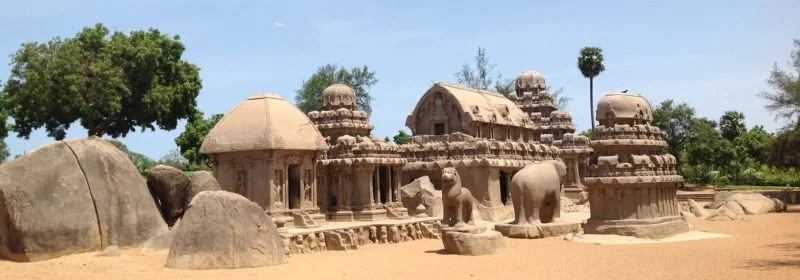The Five Rathas, located in Mahabalipuram, Tamil Nadu, India, are a set of magnificent monolithic rock-cut temples that showcase the brilliance of ancient Indian architecture and artistry.
These rathas, or chariots, are part of the UNESCO World Heritage Site of Mahabalipuram, and they represent an important chapter in the history of Indian temple architecture.Each ratha is carved from a single rock and is dedicated to a different deity from Hindu mythology.
This comprehensive guide will delve into the history, geography, architecture, and significance of these extraordinary structures, offering a detailed exploration of the Five Rathas.
1. History

The history of the Five Rathas at Mahabalipuram is intertwined with the rise and fall of the Pallava dynasty, one of the most influential dynasties in the history of South India.
The Pallavas ruled over parts of present-day Tamil Nadu and Andhra Pradesh from the 3rd to the 9th century CE, leaving behind a legacy of magnificent temples, sculptures, and architectural marvels.
Moreover, The exact date of construction of the Five Rathas is uncertain, but it is generally believed to have taken place around the 7th century CE during the reign of King Mahendravarman I and his son Narasimhavarman I.
These rulers were great patrons of art and architecture, and under their rule, Mahabalipuram flourished as a centre of artistic and cultural excellence.
Also, The Pallavas were known for their innovative architectural styles, which combined elements of Dravidian and Buddhist architecture.
The Five Rathas represent a significant development in Pallava architecture, showcasing the transition from cave temples to monolithic rock-cut temples.
Intriguing Story of the Five Rathas
Each ratha is carved entirely from a single piece of granite rock, highlighting the skill and craftsmanship of the Pallava artisans.
The naming of the rathas after the Pandava brothers and their common wife, Draupadi, from the Hindu epic Mahabharata is intriguing.
While there is no direct connection between the rathas and the Mahabharata narrative, it is believed that the Pallava kings sought to showcase their devotion to Hindu deities by dedicating each ratha to a different god or goddess.
Over the centuries, Mahabalipuram and its magnificent monuments fell into obscurity, buried under sand and debris.
It wasn’t until the 19th century that British archaeologists rediscovered these ancient treasures, sparking renewed interest in the region’s history and culture.Today, the Five Rathas stand as silent witnesses to the glory of the Pallava dynasty and India’s rich cultural heritage.
They are revered as architectural masterpieces and protected as UNESCO World Heritage Sites, attracting visitors from around the world who come to marvel at their beauty and craftsmanship.
2. Geography

The Five Rathas, situated in Mahabalipuram, Tamil Nadu, India, are an integral part of the town’s rich cultural and historical landscape.
Mahabalipuram, also known as Mamallapuram, is a coastal town on the southeastern coast of India, located in the Kancheepuram district of Tamil Nadu.
Its strategic coastal location has significantly shaped its history and cultural development over the centuries.
Mahabalipuram is renowned for its ancient rock-cut temples, monolithic sculptures, and UNESCO World Heritage Sites, which attract tourists, scholars, and history enthusiasts from all corners of the globe.
Also, The town’s proximity to the Bay of Bengal adds to its allure, offering stunning sea vistas and creating a serene and picturesque setting for its architectural wonders.
The town of Mahabalipuram is well-connected by road and is easily accessible from major cities such as Chennai and Pondicherry.
It is approximately 58 kilometres south of Chennai, the capital city of Tamil Nadu, making it a popular day trip destination for tourists visiting the region.
Moreover, The Five Rathas, located within the town limits of Mahabalipuram, are nestled amidst a lush green landscape surrounded by coconut groves and sandy beaches.
The site’s tranquil ambience provides visitors with a sense of serenity and tranquility as they explore the ancient monuments and soak in the beauty of their surroundings.
The geographical location of Mahabalipuram, with its temperate climate and scenic coastal vistas, makes it an ideal destination for tourists seeking to explore India’s rich cultural heritage while enjoying the natural beauty of its coastal landscapes.
Whether admiring the intricate carvings of the Five Rathas or strolling along the picturesque beaches, Mamallapuram offers a unique blend of history, culture, and natural beauty that captivates the hearts and minds of all who visit.
3. Architecture

The architecture of the Five Rathas at Mahabalipuram is a remarkable testament to the skill, ingenuity, and artistic vision of the Pallava artisans who created them.
Carved entirely from solid granite rock, these monolithic structures exemplify the transition from cave temples to free-standing architectural wonders.
Each ratha is unique in its design, dedicated to a different deity from Hindu mythology, and showcases a distinct architectural style and decorative motifs.
Moreover, Amidst these architectural marvels, the influence of Tamil culture, symbolized by the Tamil Sword, subtly intertwines with the broader narrative of Hindu mythology, enriching the cultural tapestry depicted in the intricate carvings and designs.
Also, The rathas are named after the Pandava brothers and their shared wife, Draupadi, from the Hindu epic Mahabharata, though they are not directly related to the epic’s narrative.
Let’s delve deeper into the architectural features of each ratha:
1. Draupadi Ratha
The Draupadi Ratha, dedicated to Goddess Durga, is the smallest yet one of the most charming structures among the Five Rathas at Mahabalipuram. It represents a unique blend of simplicity and elegance in Pallava architecture.
This Ratha is characterized by its square sanctum topped with a pyramidal roof, surrounded by a pillared veranda. What sets the Draupadi Ratha apart is its intricate carvings and delicate ornamentation.
Moreover, the pillars and panels of the veranda are adorned with sculpted figures and motifs, depicting scenes from Hindu mythology with remarkable detail and precision.
Despite its modest size, the Draupadi Ratha exudes a sense of grace and sophistication, showcasing the Pallava artisans’ mastery of stone carving techniques.
The sanctum, though small, radiates a sense of divinity and sacredness, inviting visitors to pause and reflect in its serene ambiance.
As visitors explore the Draupadi Ratha, they are transported to a world of myth and legend, where gods and goddesses come to life in stone.
Its intricate carvings and artistic details offer a glimpse into the rich cultural heritage of ancient India, inspiring awe and admiration in all who behold its beauty.
Furthermore, the Draupadi Ratha is a testament to the Pallava dynasty’s artistic prowess and spiritual devotion, serving as a timeless symbol of India’s architectural and cultural legacy.
2. Arjuna Ratha
The Arjuna Ratha, dedicated to Lord Shiva, stands as a magnificent representation of Pallava architectural brilliance and artistic creativity.
Among the Five Rathas at Mahabalipuram, it captivates visitors with its intricate carvings, elaborate design, and symbolic significance.
Designed to emulate a horse-driven chariot, the Arjuna Ratha’s structure is adorned with a wealth of sculptural details.
Its exterior walls are resplendent with mythical creatures, celestial beings, and divine motifs, all meticulously carved into the solid granite rock.
Also, These carvings depict scenes from Hindu mythology and epic tales, bringing to life the rich cultural heritage of ancient India.
Moreover, pillars, cornices, and kudus (miniature shrines) embellish the façade of the Arjuna Ratha, adding to its grandeur.
Each element is intricately crafted, showcasing the Pallava artisans’ mastery of stone carving techniques and keen attention to detail.
Despite the passage of centuries, the Arjuna Ratha continues to awe visitors with its architectural complexity and artistic finesse.
It is a testament to the Pallava dynasty’s cultural and artistic achievements and a timeless symbol of devotion and reverence for Lord Shiva.
As visitors explore the Arjuna Ratha, they are transported back to an era of artistic flourishing and spiritual devotion. Its exquisite beauty and historical significance make it a must-see attraction for anyone interested in Indian art, architecture, and culture.
3. Bhima Ratha
The Bhima Ratha, dedicated to Lord Vishnu, is the grandest and most elaborate of the Five Rathas at Mahabalipuram. It showcases the pinnacle of Pallava architectural brilliance and religious devotion.
Rising majestically, the Bhima Ratha commands attention with its towering structure and intricate architectural details.
Designed as a three-story temple, it exudes grandeur with multiple levels adorned with ornate carvings and decorative motifs.
Also, the sanctum, crowned with a pyramidal roof, serves as the focal point of the structure, radiating a sense of divine presence and spiritual significance.
The exterior walls of the Bhima Ratha are a canvas of sculpted panels depicting scenes from Hindu mythology. Each carving is a masterpiece of craftsmanship, bringing to life tales of gods, goddesses, and mythical beings.
Moreover, pillared verandas, miniature shrines, and intricate friezes adorn the structure, showcasing the Pallava artisans’ mastery of temple architecture and stone carving techniques.
Despite the passage of centuries, the Bhima Ratha continues to captivate visitors with its architectural splendor and symbolic significance.
It is a testament to the Pallava dynasty’s cultural legacy and spiritual devotion, inspiring awe and reverence in all who behold its beauty.
Furthermore, As visitors explore the Bhima Ratha, they are transported to a bygone era of artistic flourishing and religious fervor.
Its magnificent beauty and historical importance make it a cherished treasure of Indian heritage, a beacon of spirituality and architectural excellence for generations to come.
4. Nakula-Sahadeva Ratha
The Nakula-Sahadeva Ratha, dedicated to Lord Indra, presents a unique charm among the Five Rathas at Mahabalipuram with its simplicity and understated elegance.
Though smaller in scale than some of its counterparts, the Nakula-Sahadeva Ratha’s design carries a quiet dignity. The square sanctum, crowned with a pyramidal roof, forms the focal point of the structure, radiating a sense of sacredness and serenity.
Moreover, the exterior walls, adorned with subtle decorative elements, showcase the Pallava artisans’ skillful craftsmanship and attention to detail.
Despite being believed to be incomplete, the Nakula-Sahadeva Ratha’s unfinished state adds to its allure, offering a glimpse into the Pallava’s artistic process and vision.
Moreover, Its rough-hewn carvings and minimalist design evoke a sense of authenticity and timelessness, inviting visitors to appreciate its raw beauty and historical significance.
As visitors explore the Nakula-Sahadeva Ratha, they are drawn into a contemplative journey, reflecting on the ingenuity and creativity of ancient artisans and the enduring legacy of Indian temple architecture.
Despite its humble appearance, this ratha stands as a testament to the Pallava dynasty’s cultural heritage and artistic legacy, enriching the spiritual landscape of Mahabalipuram and inspiring awe and admiration in all who encounter it.
5. Dharmaraja Ratha
The Dharmaraja Ratha, dedicated to Lord Yama, the god of death, stands as a striking testament to Pallava architectural ingenuity and religious symbolism among the Five Rathas at Mahabalipuram.
Designed to resemble a chariot drawn by elephants, the Dharmaraja Ratha commands attention with its imposing structure and intricate carvings.
Also, Its exterior walls are adorned with many sculptural panels depicting scenes from the Mahabharata and other Hindu myths, showcasing tales of heroism, cosmic battles, and divine intervention.
Furthermore, The sanctum, crowned with a pyramidal roof and adorned with sculpted pillars, serves as the focal point of the ratha, radiating a sense of sacredness and reverence.
Additionally, pillared verandas and miniature shrines add to the architectural grandeur, while intricate friezes and decorative motifs embellish the façade, capturing the eye and inspiring wonder.
Despite its dedication to the god of death, the Dharmaraja Ratha exudes life and vitality, a powerful symbol of spiritual belief and devotion.
Moreover, as visitors explore its intricate carvings and architectural details, they are transported to a realm of myth and legend, where gods and mortals intertwine in a timeless dance of cosmic significance.
The Dharmaraja Ratha is a beacon of Pallava cultural heritage and artistic excellence, inviting visitors to delve into the rich tapestry of Indian mythology and spirituality.
Furthermore, Its enduring beauty and historical significance make it a cherished treasure of Mahabalipuram, a testament to the profound legacy of the Pallava dynasty in shaping India’s architectural and religious landscape.
Conclusion
The Five Rathas at Mahabalipuram are not just architectural marvels but also a testament to India’s rich cultural and artistic heritage.
They stand as a reminder of the skill and craftsmanship of the ancient Pallava artisans, who created these magnificent structures out of solid rock.
Also, Visiting the Five Rathas is a journey back in time, allowing one to experience the grandeur and beauty of ancient Indian architecture.
For more festival related information Click Here.
FAQ
Q. What is the significance of the Five Rathas?
A. The Five Rathas are significant for their architectural and historical importance. They showcase the development of temple architecture in India and provide valuable insights into the artistic and cultural achievements of the Pallava dynasty.
Q. How were the Five Rathas constructed?
A. The Five Rathas were carved out of solid granite rock using chisels and hammers. The process would have been extremely labor-intensive and required skilled artisans to achieve the intricate carvings and designs in the rathas.
Q. Are the Five Rathas still used for worship?
A. No, the Five Rathas are no longer used for worship. They are considered archaeological monuments maintained by the Archaeological Survey of India (ASI) for their historical and cultural significance.
Q. What is the best time to visit the Five Rathas?
A. The Five Rathas can be visited throughout the year, but the best time is during the winter months (October to March) when the weather is pleasant and conducive to exploring the outdoor site.
Are there any restrictions on visiting the Five Rathas?
A. Visitors are advised to adhere to the rules and regulations set by the ASI, which include not touching the carvings, not littering, and not defacing the monuments in any way.


